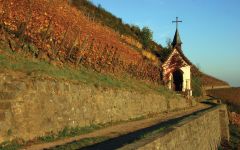Zind-Humbrecht Clos Jebsal Pinot Gris (375ML half-bottle) 2008
-
Wine
Spectator -
Robert
Parker




Product Details
Your Rating
Somm Note
Winemaker Notes
Enjoy with delicate, fruity desserts or blue cheeses.
Professional Ratings
-
Wine Spectator
A sweet, smoky thread winds through this, accenting the baked peach, cardamom, papaya, candied blood orange and crushed pine needle notes. A finely layered wine, subtly weaving in the powerful acidity, while the smoke note gains intensity toward the stony, mineral-driven finish. A lot of power partnered with equal finesse. Drink now through 2030.
-
Robert Parker's Wine Advocate
Give this at least half a dozen years in bottle for it to calm down; then, figure it will be worth following for at least another 20.
Other Vintages
2011-
Wine
Spectator -
Robert
Parker
-
Robert
Parker -
Wine
Spectator










Certified Organic and Biodynamic.

Apart from the classics, we find many regional gems of different styles.
Late harvest wines are probably the easiest to understand. Grapes are picked so late that the sugars build up and residual sugar remains after the fermentation process. Ice wine, a style founded in Germany and there referred to as eiswein, is an extreme late harvest wine, produced from grapes frozen on the vine, and pressed while still frozen, resulting in a higher concentration of sugar. It is becoming a specialty of Canada as well, where it takes on the English name of ice wine.
Vin Santo, literally “holy wine,” is a Tuscan sweet wine made from drying the local white grapes Trebbiano Toscano and Malvasia in the winery and not pressing until somewhere between November and March.
Rutherglen is an historic wine region in northeast Victoria, Australia, famous for its fortified Topaque and Muscat with complex tawny characteristics.

With its fairytale aesthetic, Germanic influence and strong emphasis on white wines, Alsace is one of France’s most unique viticultural regions. This hotly contested stretch of land running north to south on France’s northeastern border has spent much of its existence as German territory. Nestled in the rain shadow of the Vosges mountains, it is one of the driest regions of France but enjoys a long and cool growing season. Autumn humidity facilitates the development of “noble rot” for the production of late-picked sweet wines, Vendange Tardive and Sélection de Grains Nobles.
The best wines of Alsace can be described as aromatic and honeyed, even when completely dry. The region’s “noble” varieties, the only ones permitted within Alsace’s 51 Grands Crus vineyards, are Riesling, Gewurztraminer, Muscat, and Pinot Gris.
Riesling is Alsace’s main specialty. In its youth, Alsace Riesling is dry, fresh and floral, but develops complex mineral and flint character with age. Gewurztraminer is known for its signature spice and lychee aromatics, and is often utilized for late harvest wines. Pinot Gris is prized for its combination of crisp acidity and savory spice as well as ripe stone fruit flavors. Muscat, vinified dry, tastes of ripe green grapes and fresh rose petal.
Other varieties grown here include Pinot Blanc, Auxerrois, Chasselas, Sylvaner and Pinot Noir—the only red grape permitted in Alsace and mainly used for sparkling rosé known as Crémant d’Alsace. Most Alsace wines are single-varietal bottlings and unlike other French regions, are also labeled with the variety name.
